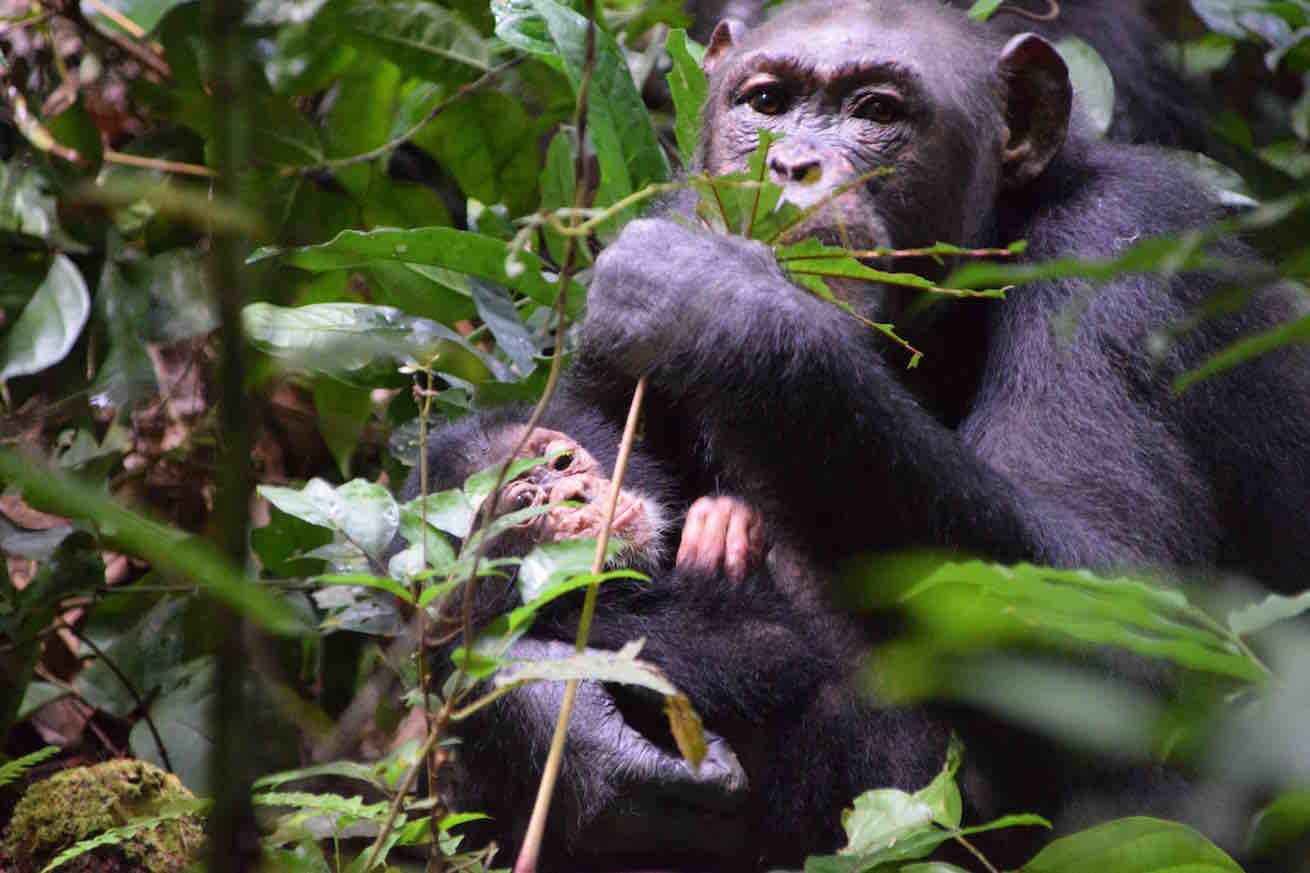- In 2017 and 2018, monkeypox viral outbreaks struck three chimpanzee communities in Taï National Park in Côte d’Ivoire.
- Researchers investigating the outbreaks found that very few individuals actually showed the characteristic smallpox-like skin rashes on their bodies associated with monkeypox; many chimps that only exhibited respiratory symptoms like coughing with few or no rashes also had high viral loads of monkeypox virus DNA in their feces.
- Detecting monkeypox viral DNA in individuals with only respiratory symptoms suggests that the same might be true in humans, researchers say, which could mean that monkeypox cases could be going undiagnosed.
- This study is the first-of-its kind deep dive into monkeypox virus transmission among wild primates.
In January 2017, researchers noticed two ill chimpanzees in Taï National Park in Côte d’Ivoire. The baby and adolescent West African chimpanzees (Pan troglodytes verus) were coughing, breathing hard, and there was discharge from their nose and eyes. Each also had a single fluid-filled blister on its mouth.
Livia Patrono, a postdoctoral associate at the Robert Koch Institute in Germany, and her colleagues observed these symptoms in two individuals of the south chimpanzee community, one of the four groups of habituated chimps researchers regularly monitor in the park. At the time, the team wasn’t sure of the diagnosis. Chimpanzees in the park have suffered from various respiratory diseases of human origin in the past, including the human metapneumovirus and the human coronavirus (HCoV) OC43, any of which could have triggered the symptoms.
But between March and April 2017, 11 chimpanzees in the north community fell visibly ill. Of these, three babies developed skin lesions on their bodies. One infant died. In a third outbreak, in May 2018, an infant in the east chimpanzee community developed similar rashes. The skin lesions were an important clue: they hinted at monkeypox, an infectious zoonotic disease known to cause smallpox-like rashes on the body.

To confirm this hunch, the team analyzed feces, urine and partially eaten fruit pieces discarded by chimps from all three communities. They found monkeypox viral DNA in all three kinds of samples. The animals had indeed been infected by the monkeypox virus, the researchers report in a new study published in Nature Microbiology. In fact, on analyzing the viral genomes, the team found that the virus had likely been present in the park since at least the early 2000s.
“It does not surprise me that we find more and more pathogens in the forest,” said co-author Roman Wittig, a senior scientist at the Max Planck Institute for Evolutionary Anthropology in Germany, who leads the Taï Chimpanzee Project (TCP) in TNP. “Knowing about them will … prepare us to react better when the next pandemic comes.”
Monkeypox, caused by a virus of the Orthopoxvirus genus, which includes the smallpox virus, was first detected in 1958 in captive crab-eating macaques (Macaca fascicularis). Since then, there have been several outbreaks among humans in Central and West African nations, including a recent one in the Democratic Republic of Congo, as well as cases in the U.S., U.K. and Singapore. But how the disease spreads in wild animals remains poorly known.
In the past, the monkeypox virus has been isolated from a Thomas’s rope squirrel (Funisciurus anerythrus) in the DRC, and a sooty mangabey (Cercocebus atys atys) in TNP. Captive chimpanzees in two wildlife sanctuaries in Cameroon also reportedly suffered from monkeypox in 2014 and 2016. “But currently there’s no scientific publication available investigating these outbreaks,” Patrono said.

This makes the latest study from TNP the first-of-its kind deep dive into monkeypox virus transmission among wild primates.
Key to the investigation was the huge data repository at TCP. For decades, TCP and its partners have collected observations of chimp behavior and health. Every day, each cough, sneeze or moment of unusual lethargy gets recorded, along with other details. The project has also accumulated large collections of chimpanzee feces, urine and partly eaten fruits as part of the chimps’ health surveillance. This long-term data allowed Patrono and her colleagues to not only look for monkeypox virus DNA in samples of chimps that were showing symptoms, but also compare them with samples from asymptomatic individuals, and samples collected before and after the outbreaks.
The findings were telling. Until now, eruption of skin rash is considered a typical clinical sign of monkeypox, at least in humans. But in the TNP chimpanzee population, individuals that only exhibited respiratory signs like coughing with few or no rashes also had high viral loads of monkeypox virus DNA in their feces. Some asymptomatic adults also tested positive for the virus in their feces. This surprised the researchers.
“The fact that we could detect monkeypox viral infections in individuals without obvious skin rash suggests that perhaps the same might be true in humans, and perhaps there could be monkeypox cases that go undiagnosed,” Patrono said.
To see how the virus spreads, the team turned to the apes’ behavioral records. They found that asymptomatic adults who tested positive for the virus in their feces tended to be involved in higher grooming activity than those who tested negative. “As part of the grooming activity, we observed the chimpanzees picking on the lesions of sick individuals and eating the crusts,” Patrono said. “That could explain the detection of monkey pox virus DNA in the feces of these individuals.”
Whether the virus had passed passively through their digestive tracts, or actually triggered an asymptomatic infection in the chimps is difficult to tell, she added.

In general, though, chimpanzees decreased their grooming activity during the outbreak compared to the previous trimester. Could the chimps be resorting to physical distancing to minimize infections? There’s too little evidence to say that, Patrono said. “It would indeed be interesting to see whether there’s a trend that chimpanzees decrease their interactions in presence of a disease, but we haven’t analysed this type of behavioral data for other disease outbreaks in this chimpanzee population yet.”
Flies could also be playing a role in monkeypox transmission. The team isolated live monkeypox virus from flies around the chimps’ feces and carcass of the dead baby. In a previous study, the researchers had shown that flies in TNP carried the bacterium causing sylvatic anthrax, a disease that’s led to many monkey and chimp deaths in the park. As the flies move across the park, they could be moving the virus across the habitat, and perhaps also to other species, Patrono said.
“What stands out is the comprehensive way the authors investigated the outbreak, from behaviour causes to mechanisms of transmission,” said Alexander Piel, a primatologist at the Liverpool John Moores University, U.K., who was not involved in the study.
A lot still remains unknown about monkeypox. How common the disease is in chimpanzees and other great apes is unclear, as is the definitive identity of a reservoir host. But the study provides a framework that can be applied to study other disease outbreaks among chimps, including COVID-19 if it were to happen, Patrono said.
“The study is a lesson in the importance of long-term health monitoring, not just of humans but also wildlife,” Piel added.
Citation:
- Patrono, L. V., Pléh, K., Samuni, L., Ulrich, M., Röthemeier, C., Sachse, A., … Leendertz, F. H. (2020). Monkeypox virus emergence in wild chimpanzees reveals distinct clinical outcomes and viral diversity. Nature Microbiology. doi:10.1038/s41564-020-0706-0
Correction: This article was updated June 5 to clarify that while monkeypox virus DNA was detected in samples from some asymptomatic individuals, high viral load was only detected in individuals with respiratory and other symptoms.
Shreya Dasgupta is an independent science writer based in Bangalore, India. Follow her on Twitter @ShreyaDasgupta.
FEEDBACK: Use this form to send a message to the author of this post. If you want to post a public comment, you can do that at the bottom of the page.